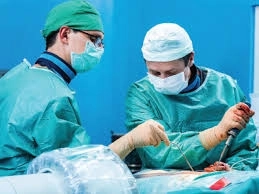
Pelvic Reconstructive Surgery: When Does a Woman Need It?
Published on: 2025-06-29 | Written by: Dr. Ihab El-Tayeb, Consultant of Obstetrics, Gynecology and IVF
Dr. Ehab El-Tayeb, Consultant in Obstetrics, Gynecology, IVF, Oncological and Cosmetic Gynecological Surgery, Fellow of the Royal Colleges in London and Dublin, and holder of the European Board in Gynecologic Oncology and Pelvic Reconstructive Surgery (EBCOG – Brussels), explains in this article when pelvic reconstructive surgery becomes necessary, and the latest surgical techniques used to treat pelvic floor weakness and organ prolapse.
What Is Pelvic Reconstructive Surgery?
Pelvic reconstructive surgery refers to a group of gynecological procedures aimed at repairing and restoring pelvic organs that have prolapsed or become weakened due to dysfunction of the pelvic floor muscles and ligaments. Conditions include:
-
Uterine prolapse
-
Bladder prolapse (stress urinary incontinence)
-
Rectal prolapse
-
Vaginal laxity or widening
What Causes Pelvic Floor Weakness?
According to Dr. Ehab El-Tayeb, the most common contributing factors include:
-
Multiple natural deliveries, especially with vacuum or forceps assistance
-
Aging and menopause, which reduce tissue elasticity
-
Obesity, causing constant pressure on the pelvic floor
-
Chronic coughing or constipation, leading to repeated strain
-
Previous pelvic surgeries, which may weaken internal support structures
When Does a Woman Need Pelvic Reconstructive Surgery?
Dr. Ehab El-Tayeb recommends surgical intervention in the presence of the following symptoms:
-
A sensation of heaviness or pressure in the vagina
-
Pain or difficulty during sexual intercourse
-
Stress urinary incontinence or involuntary leakage
-
Bulging tissue from the vaginal opening
-
Incomplete emptying of the bladder or bowel
Proper evaluation is essential and may include a clinical exam, ultrasound, and sometimes a vaginal scope.
What Are the Types of Pelvic Reconstructive Surgeries?
Dr. Ehab El-Tayeb explains that the surgical approach depends on each case, and may include:
1. Anterior or Posterior Vaginal Wall Repair
To correct bladder or rectal prolapse.
2. Uterine or Vaginal Vault Suspension
Using specialized sutures or mesh to support prolapsed organs.
3. Sphincter Repair for Urinary Control
In cases of stress urinary incontinence.
4. Combining Reconstructive and Cosmetic Gynecologic Surgery
To restore both function and appearance, enhancing comfort and confidence.
Advantages of Modern Techniques with Dr. Ehab El-Tayeb:
-
Performed vaginally or laparoscopically
-
Shorter hospital stay
-
Excellent functional and aesthetic results
-
Quick return to daily life
-
Precision techniques that reduce recurrence

